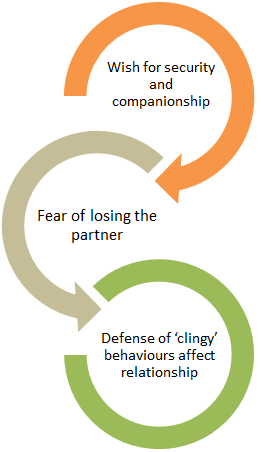Picture this: Most of us have had a secret crush. We daydream about the person and really wish to be with them. However, when they’re around, we feel extremely anxious and do all that we can to avoid their gaze or being noticed by them. Do you see the irony? On one hand, we so wish to talk to this crush and yet, here we are – pretending to not even look at them! What exactly is happening here? Why don’t we approach the person despite wanting to?
What usually holds us back, is the fear of them rejecting us. This fear is so strong, that we act on it and avoid them, instead of focusing on our wish – which is, to strike a conversation. David Malan, in 1976, recognized such patterns – which manifested across several situations. He called it the Triangle of Intrapsychic Conflict, composed of wish, fear and defense. Let’s look at each of these and understand how these three elements interact with one another.
A wish naturally emerges out of the need to survive or live healthy, safe and secure lives. By definition, a wish can either be fulfilled or not, depending upon the support of a whole lot of factors out of control. If the wish is coupled with this understanding that it may or may not be fulfilled, one can try to work on it without much stress. However, a wish that is too strong, brings fear into the picture.
The fear of non-fulfilment of the wish, creates all kinds of scenarios in the mind, terrifying ones – of what might happen if the wish doesn’t get fulfilled. We feel overwhelmed with anxiety and begin to seek relief from this state. So now, we do not do things to aid our wish, but instead, start operating out of fear to avoid the dangers, giving birth to a defense.
The defense at first, appears to allay the fear and gives us some respite, but inevitably, takes us farther away from the wish. As we move away from the wish, the anxiety grows, making our defense more rigid. Thus, the cycle becomes more and more powerful with each instance, making us feel trapped. These cycles seem to be unbreakable and tend to become more predictable over time.
This pattern occurs across different kinds of situations, contexts, relationships and emotions. We couldn’t think of a better words to sum up this phenomena, than the ones by the wise tortoise from Kung Fu Panda:
“One often meets his destiny on the path he takes to avoid it.” – Master Oogway, Kung Fu Panda
Read on to get a glimpse into some manifestations of this inner conflict, as each of our psychologist elaborates on a particular variation.
[fusion_builder_container hundred_percent=”yes” overflow=”visible”][fusion_builder_row][fusion_builder_column type=”1_1″ background_position=”left top” background_color=”” border_size=”” border_color=”” border_style=”solid” spacing=”yes” background_image=”” background_repeat=”no-repeat” padding=”” margin_top=”0px” margin_bottom=”0px” class=”” id=”” animation_type=”” animation_speed=”0.3″ animation_direction=”left” hide_on_mobile=”no” center_content=”no” min_height=”none”][fusion_title size=”2″]The Conflict Triad in Parenting:[/fusion_title]
“Parenting in the contemporary world is becoming increasingly stressful and conflict-ridden. Naturally, parents want to look out for their children and wish for them to do well. However, this natural wish can create a lot of anxieties when one notices the competition around.” – Sadia
[/fusion_builder_column][fusion_builder_column type=”1_2″ last=”no”]This fear of the child lagging behind, ‘in comparison to others’ especially, can become overwhelming when a child does not want to study or under-performs or is distracted often. The defense in response to this fear is over-checking on the child, criticizing him, comparing him to other children and so on.
Why this defense contradicts the wish is because parental criticism, instead of helping – actually lowers the child’s self-esteem and ultimately impedes his growth in the world.[/fusion_builder_column]
[fusion_builder_column type=”1_2″ last=”yes”]
[fusion_builder_column type=”1_1″ background_position=”left top” background_color=”” border_size=”” border_color=”” border_style=”solid” spacing=”yes” background_image=”” background_repeat=”no-repeat” padding=”” margin_top=”0px” margin_bottom=”0px” class=”” id=”” animation_type=”” animation_speed=”0.3″ animation_direction=”left” hide_on_mobile=”no” center_content=”no” min_height=”none”][fusion_title size=”2″]The Conflict Triad in Intimate Relationships:[/fusion_title]
“Often, in intimate relationships, the desire to hold on to the relationship or the person can become too strong, leading the other partner to feel suffocated and move further away, ironically making the fear grow stronger.” -Michelle.
[/fusion_builder_column][fusion_builder_column type=”1_2″ last=”no”]
[fusion_builder_column type=”1_2″ last=”yes”]
Let’s look at a couple, newly in a relationship. The man does everything he can to be with her as much as possible. He compulsively calls her, keeps showing up at her work place and even tries to protect her when she does not need help or protection. All these behaviours lead his girlfriend to feel very claustrophobic. She begins to get angry with him as she feels his is invading her space, and gradually, begins to avoid him. What might be happening here?
It is this fear of losing her and something happening to her leads him to become clingy so, these behaviours – instead of pulling her close to him, makes her pull away from him. He does not get what he wants and wishes and sees his fear coming close, ironically, when all this while, he was trying to avoid it.[/fusion_builder_column]
[fusion_builder_column type=”1_1″ background_position=”left top” background_color=”” border_size=”” border_color=”” border_style=”solid” spacing=”yes” background_image=”” background_repeat=”no-repeat” padding=”” margin_top=”0px” margin_bottom=”0px” class=”” id=”” animation_type=”” animation_speed=”0.3″ animation_direction=”left” hide_on_mobile=”no” center_content=”no” min_height=”none”][fusion_title size=”2″]The Conflict Triad at Work:[/fusion_title]
The triangle of conflict often manifests in team meetings at the workplace, where disagreements abound. Sometimes, during such conflict of opinions, an individual may choose to remain silent and does not end up expressing her true opinions or feelings about the issue at hand. Much after a decision has been taken, she might start feeling misunderstood by her colleagues or left out from the project.
“What happens at work is that one wishes to express her point of view and feel belonged, but may also fear upsetting others and therefore, being left alone. During a conflict, her fear overpowers her wish and she chooses to avoid any conflict – but ironically, feels unheard and left out in the end – something that she wanted to prevent.” – Kavya
Imagine a Supervisor wanting to be respected by his employees. He wishes it so strongly that he begins to fear his employees disrespecting him. To cope with this fear, he lashes out at his employees, not giving them a chance to question him.
“A boss, feeling insecure on the inside, masks it by feeling proud at being able to ‘shush’ his employees; yet at some level, he comes to realize that he is not respected by them and feels the anxiety all over again. And the cycle just goes on.” – Sindhura
[/fusion_builder_column][fusion_builder_column type=”1_1″ background_position=”left top” background_color=”” border_size=”” border_color=”” border_style=”solid” spacing=”yes” background_image=”” background_repeat=”no-repeat” padding=”” margin_top=”0px” margin_bottom=”0px” class=”” id=”” animation_type=”” animation_speed=”0.3″ animation_direction=”left” hide_on_mobile=”no” center_content=”no” min_height=”none”][fusion_title size=”2″]The Conflict Triad in Families:[/fusion_title]
Often, newly married women in our country find themselves struggling to strike a balance between adapting to the new house and her in-laws and retaining her individuality. She wishes to stand for herself and express her true self. However, she strongly fears being rejected by them. One defense in response to such fear sometimes, is over adaptation or becoming overly compliant. Though the defense may seem to be helping at first, it quickly becomes a concern in the long run:
Having to constantly please others, can make individuals feel disconnected from their true self. It is in such situations that one hears people saying, “I have not truly lived my life” or “I feel like I have been living somebody else’s life”. Gradually, it becomes like an alternate version of yourself that you start building and living till you recognize it. – Gitali
[/fusion_builder_column][fusion_builder_column type=”1_1″ background_position=”left top” background_color=”” border_size=”” border_color=”” border_style=”solid” spacing=”yes” background_image=”” background_repeat=”no-repeat” padding=”” margin_top=”0px” margin_bottom=”0px” class=”” id=”” animation_type=”” animation_speed=”0.3″ animation_direction=”left” hide_on_mobile=”no” center_content=”no” min_height=”none”][fusion_title size=”2″]What can be done? How to break this triangle?[/fusion_title]
Working with the Wish:
Healthy functioning is about working towards a wish with a healthy acceptance that it may or may not be fulfilled and not necessarily in the way we want it.
Know that it is not the end of the world. Of course there are things that we can want badly, but they don’t have to happen exactly how we want them to. Learning to wish, rather than demand – can go a long way in helping us deal with different possible outcomes.
Also, at times, we hesitate to even openly express our wish and instead act on our fears. If the boyfriend in the above example shared his wish with his girlfriend – that of him wanting to feel secure in the relationship, things would have been different. It is important at time to recognize the wish behind our fears and let it come to the forefront.
Working with the Fear:
Fears are not always irrational or a hindrance. Evolutionarily, fear as an emotion serves the function of protecting us from danger. Thus, most of our fears may have an intent – they may be protecting you against a harm, a pitfall. Understand that and be compassionate toward yourself as well as the fear. Practising mindfulness with different emotions allows us to be more accepting of our own selves and helps us regulate emotions in a healthy fashion.
Working with the Defense:
Anxiety arises from the fact that wish and fear are in conflict. The defense is created to quell the anxiety. Understanding that the anxiety is an outcome of an internal conflict rather than environmentally induced, could help us deal with it differently. – Namrata.
When we believe that anxiety is a result of something external, we develop defenses – like avoidance, to deal with it. That often, does not help in the long run. Hence, such an understanding is needed to look at anxiety in a different light, the aim of which would be to find a behaviour that helps allay the fear as well as does not take us away farther from the wish.
Our mind creates anxiety so that we do not go ahead toward change – the kind of change that will help us ‘grow’. Why?
“At times, even a seemingly positive step brings along with it some unpleasant feelings. A part of our mind that is assigned to make us ‘feel good’ misinterprets the situation and tries to get us away from this change, though it might lead us to what we really want.” – Kunjal.
The idea is to stay with the unpleasantness and restlessness and to accept that adapting to change is going to be difficult.
A Reflective Exercise:
Think of a situation, where you have been feeling largely trapped in a cycle, to a point that it has become predictable each time it occurs. Think about your role in that situation. Start by identifying your behaviour – and then reflect upon a wish and a fear that may be motivating it. Understand how both could be in conflict and be observant of your response to the anxiety.[/fusion_builder_column][/fusion_builder_row][/fusion_builder_container]


